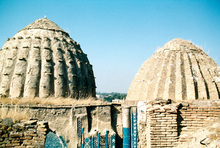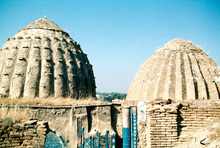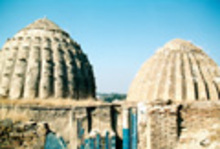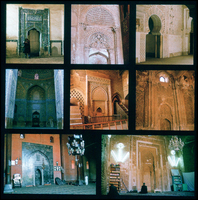| dc.coverage.spatial | Site: Samarkand (Uzbekistan) | en_US |
| dc.coverage.temporal | creation date: 1371-1383 | en_US |
| dc.coverage.temporal | creation date: 1386 | en_US |
| dc.creator | Unknown | en_US |
| dc.date | 1371-1383 | en_US |
| dc.date.accessioned | 2010-06-02T19:51:36Z | |
| dc.date.available | 2010-06-02T19:51:36Z | |
| dc.date.issued | 1371-1383 | en_US |
| dc.identifier | 143960 | en_US |
| dc.identifier.uri | http://hdl.handle.net/1721.3/53256 | en_US |
| dc.description | Typical of the mausoleums within the complex, this structure is square in plan, with a pishtaq facing the Shah-i Zinda corridor. The pishtaq rests on a decorated socle, and is detailed with semi-attached columns at the outer edges and underneath the entrance arch. A muqarnas half-dome covers the entrance portal. The interior plan is also square, with three shallow niches on each wall. An octagonal zone of transition includes muqarnas squinches and arched panels that crown the wall recesses. The dome is decorated with eight 'ribs' that emanate from an eight-pointed star within the crown. A diaper pattern fills the sections between the ribs; a teardrop medallion centered within each wedge-shaped field. Brick ribs clad the exterior of the dome, terminating with an unusual pointed cap.
The mausoleum is remarkable for the extensive employment of tile revetment. Surfaces of the interior and the pishtaq bear complete coverage executed in a diverse range of techniques including carved glazed terracotta, faience mosaic, haft-rangi, and polychrome underglaze painted tile. Other than the pishtaq, the exterior surfaces bear no trace of decorative revetment.
Source: Archnet | en_US |
| dc.description | exterior, domes of Amir Zadeh and Shadi Malik mausoleums, 1987 | en_US |
| dc.format.medium | brick | en_US |
| dc.format.medium | ceramic tile | en_US |
| dc.relation.ispartof | 139612 | en_US |
| dc.relation.ispartof | 121675 | en_US |
| dc.rights | (c) Roya Marefat 1987 | en_US |
| dc.subject | Mausoleums | en_US |
| dc.subject | Islam -- History | en_US |
| dc.subject | Necropolises | en_US |
| dc.subject | Complexes | en_US |
| dc.subject | Architecture, Islamic--Asia, Central | en_US |
| dc.subject | Religious architecture | en_US |
| dc.subject | Architecture, Islamic --Uzbekistan | en_US |
| dc.subject | Decoration and ornament, Islamic | en_US |
| dc.subject | Sepulchral monuments | en_US |
| dc.subject | Tiles, Islamic | en_US |
| dc.subject | Domes | en_US |
| dc.title | Shad-i Mulk Aqa Mausoleum | en_US |
| dc.title.alternative | Turkan Aqa | en_US |
| dc.title.alternative | Shadi Mulk Aka | en_US |
| dc.title.alternative | Chadi Moulk Mausoleum | en_US |
| dc.title.alternative | Shah-i Zinda | en_US |
| dc.title.alternative | Amir Zadeh Mausoleum | en_US |
| dc.title.alternative | Amirzadeh Mausoleum | en_US |
| dc.title.alternative | Amirzadah Mausoleum | en_US |
| dc.type | Image | en_US |
| dc.rights.access | All rights reserved | en_US |
| dc.identifier.vendorcode | A123 | en_US |
| vra.culturalContext | Islamic | en_US |
| vra.culturalContext | Uzbek | en_US |
| vra.technique | construction | en_US |
| vra.worktype | Tomb | en_US |
| vra.worktype | Mausoleum | en_US |
| dc.contributor.display | Islamic, Uzbek | en_US |



